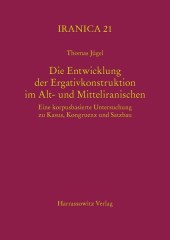 Rezai, Maryam. Dēnkard IV. Transcription, Translation and Glossary. Elmi Publication. Tehran: 2014.
Rezai, Maryam. Dēnkard IV. Transcription, Translation and Glossary. Elmi Publication. Tehran: 2014.
Dēnkard “Acts of the religion”, divided into nine books, is a summary of knowledge of the Zoroastrian religioni, written in Middle Persian (Pahlavi), from which, the first two and the beginning of the third books are lost. Two compilers of Dēnkard are known to us, Ādurfarnbag ī Farroxzādān, first author and Ādurbād Ēmēdān, second author and compiler of the Dēnkard in 9th-century.
The Dēnkard is primarily an apology for Zoroastrian religion, more specifically, Dēnkard IV, the shortest, is a text dealing with different subjects regarding the customs, arts, and sciences, which is from the same genre as one chapter of Book III. It consists of a philosophical thoughts on the aməša spəntas; an account on the role of the Persian sovereigns in the defense of Mazdayasnian Religion from the Achaemenid Darius III up to Husrauw I; some thoughts on limited and limitless time, fate, action, and free will; some thought on learning Avesta and its commentary; on arts; on the four casts of poeple; as well as on the more abstract concepts of metaphysics, e.g. considerations on the afterlife, the necessity of Mazdayasna religion and the zoroastrian ethical triad.
This volume contains a transcritption of the Dēnkard IV based on the Madan Edition as well as a Persian translation following by a facsimile of the printed Pahlavi text and a Pahlavi-Persian glossary.
In Original:
رضایی، مریم. دینکرد چهارم: آوانویسی, ترجمه، واژهنامه. انتشارات علمی. تهران: ۱۳۹۳
reżāyi, maryam. dinkard-e čahārom: āvānevisi, tarğome, vāže-nāme. entešārāt-e ʿelmi. tehrān: 1393
 The latest issue of the Journal of the American Oriental Society, Vol. 135(3), has several articles and reviews of interest to scholars of ancient Iran. We have already announced Michael Shenkar’s Rethinking Sasanian Iconoclasm in a previous post. Among the reviews three stand out for their direct relevance for Iranian Studies:
The latest issue of the Journal of the American Oriental Society, Vol. 135(3), has several articles and reviews of interest to scholars of ancient Iran. We have already announced Michael Shenkar’s Rethinking Sasanian Iconoclasm in a previous post. Among the reviews three stand out for their direct relevance for Iranian Studies:

 Krasnowolska, Anna & Renata Rusek-Kowalska (eds.). 2015.
Krasnowolska, Anna & Renata Rusek-Kowalska (eds.). 2015.  Jügel, Thomas. 2015.
Jügel, Thomas. 2015.  Chunakova, Olga Mikhailovna. 2015.
Chunakova, Olga Mikhailovna. 2015.  Panaino, Antonio. 2014.
Panaino, Antonio. 2014. 

